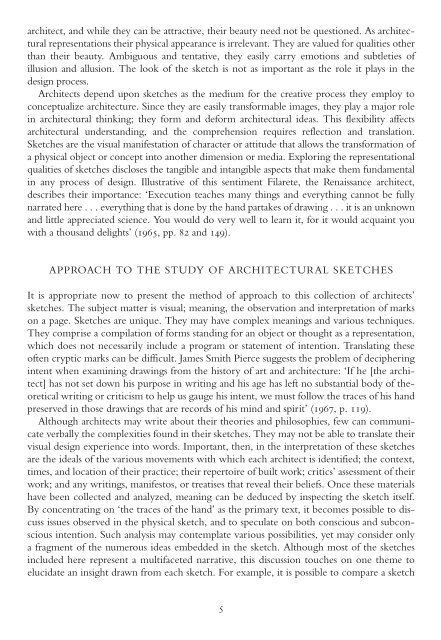Architect Drawings : A Selection of Sketches by World Famous Architects Through History
You also want an ePaper? Increase the reach of your titles
YUMPU automatically turns print PDFs into web optimized ePapers that Google loves.
architect, and while they can be attractive, their beauty need not be questioned. As architectural<br />
representations their physical appearance is irrelevant. They are valued for qualities other<br />
than their beauty. Ambiguous and tentative, they easily carry emotions and subtleties <strong>of</strong><br />
illusion and allusion. The look <strong>of</strong> the sketch is not as important as the role it plays in the<br />
design process.<br />
<strong>Architect</strong>s depend upon sketches as the medium for the creative process they employ to<br />
conceptualize architecture. Since they are easily transformable images, they play a major role<br />
in architectural thinking; they form and deform architectural ideas. This flexibility affects<br />
architectural understanding, and the comprehension requires reflection and translation.<br />
<strong>Sketches</strong> are the visual manifestation <strong>of</strong> character or attitude that allows the transformation <strong>of</strong><br />
a physical object or concept into another dimension or media. Exploring the representational<br />
qualities <strong>of</strong> sketches discloses the tangible and intangible aspects that make them fundamental<br />
in any process <strong>of</strong> design. Illustrative <strong>of</strong> this sentiment Filarete, the Renaissance architect,<br />
describes their importance: ‘Execution teaches many things and everything cannot be fully<br />
narrated here ...everything that is done <strong>by</strong> the hand partakes <strong>of</strong> drawing ...it is an unknown<br />
and little appreciated science. You would do very well to learn it, for it would acquaint you<br />
with a thousand delights’ (1965, pp. 82 and 149).<br />
APPROACH TO THE STUDY OF ARCHITECTURAL SKETCHES<br />
It is appropriate now to present the method <strong>of</strong> approach to this collection <strong>of</strong> architects’<br />
sketches. The subject matter is visual; meaning, the observation and interpretation <strong>of</strong> marks<br />
on a page. <strong>Sketches</strong> are unique. They may have complex meanings and various techniques.<br />
They comprise a compilation <strong>of</strong> forms standing for an object or thought as a representation,<br />
which does not necessarily include a program or statement <strong>of</strong> intention. Translating these<br />
<strong>of</strong>ten cryptic marks can be difficult. James Smith Pierce suggests the problem <strong>of</strong> deciphering<br />
intent when examining drawings from the history <strong>of</strong> art and architecture: ‘If he [the architect]<br />
has not set down his purpose in writing and his age has left no substantial body <strong>of</strong> theoretical<br />
writing or criticism to help us gauge his intent, we must follow the traces <strong>of</strong> his hand<br />
preserved in those drawings that are records <strong>of</strong> his mind and spirit’ (1967, p. 119).<br />
Although architects may write about their theories and philosophies, few can communicate<br />
verbally the complexities found in their sketches. They may not be able to translate their<br />
visual design experience into words. Important, then, in the interpretation <strong>of</strong> these sketches<br />
are the ideals <strong>of</strong> the various movements with which each architect is identified; the context,<br />
times, and location <strong>of</strong> their practice; their repertoire <strong>of</strong> built work; critics’ assessment <strong>of</strong> their<br />
work; and any writings, manifestos, or treatises that reveal their beliefs. Once these materials<br />
have been collected and analyzed, meaning can be deduced <strong>by</strong> inspecting the sketch itself.<br />
By concentrating on ‘the traces <strong>of</strong> the hand’ as the primary text, it becomes possible to discuss<br />
issues observed in the physical sketch, and to speculate on both conscious and subconscious<br />
intention. Such analysis may contemplate various possibilities, yet may consider only<br />
a fragment <strong>of</strong> the numerous ideas embedded in the sketch. Although most <strong>of</strong> the sketches<br />
included here represent a multifaceted narrative, this discussion touches on one theme to<br />
elucidate an insight drawn from each sketch. For example, it is possible to compare a sketch<br />
5




